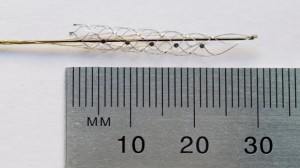
Key to the bionic spine is an electrode array the size of a small paperclip. With the aid of a catheter, this stent is inserted into the jugular vein in the neck and pushed up the vein until it reaches the motor cortex – the part of the brain at the top of the head which controls movement.
Signals from the brain picked by this device can be used to control robotic devices such as an exoskeleton or robotic arm. Paraplegic volunteers will be the first to try the device in a clinical trial starting next year.
The research, by Professor O’Brien and his team of 39 neurologists and biomedical engineers from the Royal Melbourne hospital, Melbourne University and the Florey Institute was published Feb 8th in the Journal Nature.
Read more:
